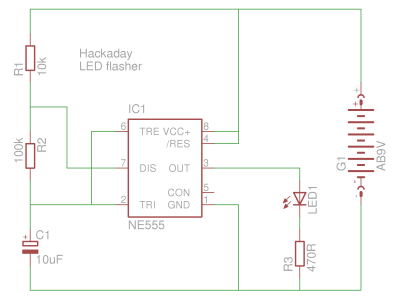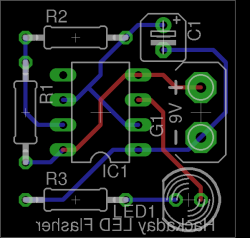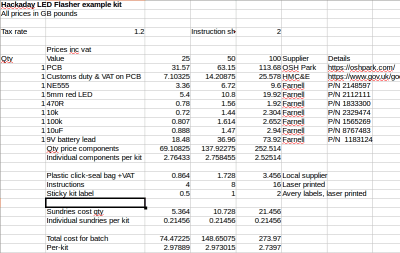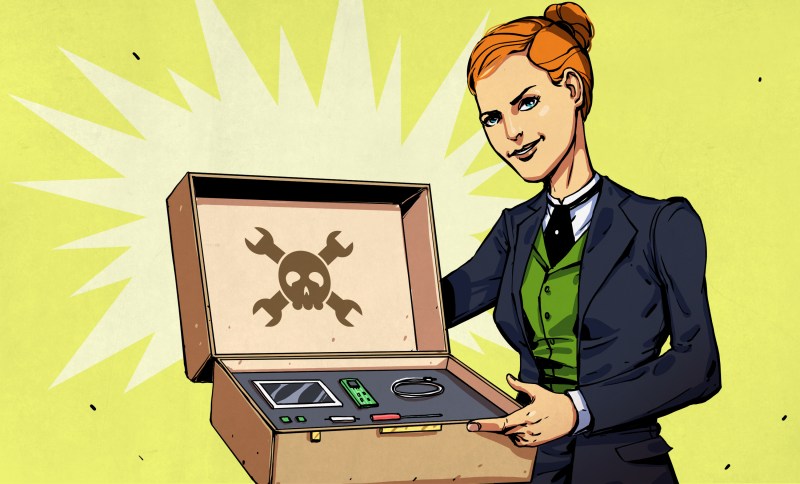In the previous article in this series on making a personal electronic project into a saleable kit, we looked at the broader picture of the kit market for a new entrant, the importance of gauging whether or not your proposed kit has a viable niche and ensuring that it has a good combination of buildability, instructions, and quality. In this article we will look at specifying and pricing the hardware side of a kit, illustrating in detail with an example project. The project we’ve chosen is a simple NE555 LED flasher which we haven’t built and have no intention of assembling into a kit for real, however it provides a handy reference project without the circuit itself having any special considerations which might distract from the job at hand.
Details, Details

Having made the decision that you have a potential product on your hands your next step is to turn it from a project into something a customer would be satisfied with. If you have not done so already, you should try to produce a prototype which will represent the product exactly as you will sell it. Given that you’ve already got it working as a project this might seem an odd thing to start with an an unnecessary repetition of effort, however the key point here is that you should use the exact components you would sell.
You should design a PCB and have a prototype run manufactured, and you should compile a detailed bill of materials complete with manufacturer or supplier part numbers which you should then order just as you would if you were assembling a batch of kits. It is true that for example a 10 K resistor from your junk box is likely to be just as good as a new one fresh from the supplier, but the point here is to replicate exactly what your customer will receive. You should pay attention to working voltages, power dissipation figures for resistors, and though you are unlikely to encounter many components containing lead these days, the RoHS status of anything you specify.
Packaging

If you can build a couple of prototypes using these components and you are happy that you have made a working and repeatable kit, you should pack an example kit in the way you would send it to the customer. Include any sundries, for example folded sheets of paper to represent kit instructions, and a sticky label for the kit packaging. Make any packaging choices, for example whether it should be sent out in a small cardboard box or a plastic bag. Your town or city should have a local bulk packaging specialist catering for everything from jewelery stores to takeaway restaurants, spend a while in their showroom looking at the options when you make those choices.
At this point you will have to consider the fragility of your components, as well as how you are going to send them to the customer. Consider for example whether you will need to provide a holder for any DIP ICs. Even go as far as to pack up a sample order in a padded envelope and weigh it to see which postal price bracket it fits in. You are likely to sell these kits internationally, so a few grams either way can make a significant difference to your postage costs.
Pricing
Once you are happy with your kit packaging, take your sample kit and itemise everything included in it. Not simply the electronic components, but the packaging, the stickers, the instructions and other sundries. Make a spreadsheet and use it to compute prices for all these constituent parts for a range of production run sizes. For a first kit it might be worth pricing up runs of 25, 50, and 100. Research suppliers and price breaks, and don’t forget to include any sales taxes if applicable as well as customs charges on anything you may have to import. This last point is particularly important if you are having a PCB made in China, for example.

We produced just such a spreadsheet for our 555 LED flasher kit. In our case it’s in GB Pounds because that’s where this article is being written, and instantly we can see that when the kit packaging is taken into consideration, a small run of LED flasher kits will cost us just under 3 pounds each. If we were making these kits for real or in a larger volume this figure would be likely to drop significantly through quantity price breaks and a lot more effort put into finding cheaper sources, however this is just an example kit product for an article and we are assuming that you will not have the luxury of a large production run for your first kit. It’s a decision you’ll have to make, how many of an unproven kit to produce, as a mountain of unsold kits can represent a significant amount of tied-up investment. Twenty five kits often seems about right from this perspective, if it sells unexpectedly quickly you can always run up a load more.
Once you have an accurate view of how much your kits will cost to produce, you can think about the price at which they can retail. You should know what other manufacturers charge for kits of similar size so you will probably have an idea where you should position the kit, however you have to recognise that producing and packing the kit is in itself a significant amount of work for which the customer should be prepared to pay. You will always find a customer with a calculator who complains that they have just paid over £5 for £2.50-worth of components, however of course they are not just paying for the components but the development work that has gone into making a satisfactory kit experience. Ensure that your retail price adequately reflects the amount of work that has gone into producing the kit without pushing the boundaries too far, and your customers will understand that they are paying in part for your effort.
Next Steps
Now you should have a clear idea of your kit’s hardware: you’ll know what to order, how much it will cost, how you are going to turn it into a product, and what price it will retail at. You aren’t ready to take it to market though, because you have yet to complete one of the most important parts of the jigsaw puzzle. Your kit has no instructions as yet, and its commercial success will hang on the instructions you ship with it. The next article in this series will therefore be devoted to those instructions, as we take you through the process of writing a set of instructions for our LED flasher example kit.
















What about the costs of CE and FCC etc… testing? How would you integrate that into the final product price? On the same subject, how would you manage to sell a product like this for ~£3 when you include the price of not only CE and FCC testing, but all the other tests required to sell internationally(EM testing for other countries etc…)?
What mnbvc said. Everyone forgets this, and sooner or later someone is going to get shafted.
Yet is there any example of any company getting significant penalties for lack of EMC testing in Europe? As far as I know, the biggest have been product recalls, and that only in very extreme cases such as disturbs TV transmissions. For a 100 pcs kit this wouldn’t be too bad.
And EMC testing for CE marking is not very expensive. For a simple device without radio transmitters, it is typically less than 500 EUR, so once you get to 1000 pcs it starts to make sense.
You’re looking at this the wrong way. This is for an engineer or hobbiest who wants to sell a kit for fun so that other hobbiests or engineers can also enjoy it. This is not about developing a consumer electronics product for retail. No kit is going be be UL/FCC/CE or any other kind of certified. An example would be Dave Jones’s microCurrent, not a fluke multimeter.
>engineer or hobbiest who wants to sell a kit
>electronics product for retail
These two statements are the same thing. If you sell your kit, be it one kit or a hundred (or for the few lucky ones, thousands), you’ve created an ‘electronics product for retail’. You may not view it that way, but you would have just sold someone something that has all the same implied ramifications (unless you have a written and signed, disclaimer, warranty, or agreement such as Tindie has for it’s Flea Market page) as if you were buying a Raspberry Pi or some other ‘consumer electronic product’.
>No kit is going be be UL/FCC/CE or any other kind of certified
Your definition of a kit, and the definition that the FCC puts forward as a kit, I can almost guarantee, are different. Except for certain types of ‘kits’, the FCC still enforces their rules. Notably, there are provisions for selling kits (as defined by the FCC) without certification.
As for CE, *someone can correct me if I’m wrong*, but for the most part CE is all about self certification. You only file a product brief with them and claim CE certification. In relation to FCC it’s cheap, until you get sued. If a product passed FCC when it shouldn’t have, the FCC will take the fall (ie, you shouldn’t be held liable for damages, but you may not be able to sell the product). When a product fails CE, you should be liable for damages, but may be able to sell the product still (just without the CE certs). This is the beauty of self certification.
I’m not an expert on CE certifications by any means, so someone please correct me if I’m wrong there. I have done my research on FCC, and am in the process of getting a product through FCC, so the pain is real and present for me right now.
You’re right. I guess it really depends on the definition of “kit.” And where the liability lies. As a hobbiest, I know almost nothing about certification and assumed selling a kit would be no different than selling a bad of random parts from a legal point of view, since the project isn’t assembled. It would be awesome if Hackaday or someone else could make a video or blog post explaining the different types of certification and how risk and liability are dealt with in the electronics industry.
Interesting you mention it, I’ve been working on a write up for what I know. Maybe a video is a better way to do it…
Virtually every country has numerous exemptions and loopholes which 98% of products sold on sites like SparkFun, Adafruit and Seeed fall into.
The FCC cert argument is making a mountain out of a molehill. There is specific language exempting “experimental”, “educational” and “hobbyists” provided the device does not knowingly broadcast or interfere with other devices outside of the user sphere of influence. The FCC does not care if your product interrupts TV in the users house. Only that it disrupts TV in their neighbors house.
Moat non-intentional EM noise on non radio equipment has short range.
Here in the US it is almost all done through insurance industry requirements. If you’re big enough that you need manufacturer’s insurance, the insurer will require you to get the device tested for safety by UL (Underwriter’s Labs). That will include FCC testing. Almost all the other rules are things your device can’t do without a license, rather than things you have to get tested for. Insurance protects you if you screw that up, and it will also require testing to make sure you didn’t. That said, if you build your own power supply that accepts AC from the line, it will have to be tested. If you use USB or batteries, or commercial DC sources under some high limit, then you don’t even need your power stage tested. But if it catches fire and you don’t have insurance, you’re on the hook for that.
LED blinker would actually fall under the clock speed of 9kHz. So a 555 implementation would not require FCC part 15 but one that uses a microcontroller would.
http://www.ustech-lab.com/fcc.html
>FCC Part 15
>Federal Regulations, Title 47 (47 CFR), Part 15 covers the rules for the operation of unintentional, intentional or incidental radiators. Any electrical or electronic devices incorporating a digital circuitry and operating with an oscillator or clock speed of greater than 9kHz requires approval to this rule.
But not all uC projects with clock speeds over 9kHz need FCC either. There are stipulations for ‘kits’ and add on boards (shields, capes, etc) for things like the Arduino, BeagleBone, and Raspberry Pi uCs and SBC. Just because something has a faster clock doesn’t mean you have to have FCC.
But @tekkieneet: I agree that this is something that should be considered by the creator of each product.
While I know there are a lot of people out there that sell without FCC certifications, justifying it by the fact that they sell only a couple hundred or thousand parts/kits/boards a year, you are still breaking the law. Is the FCC going to go after you for 10 555 blinker boards? Probably not. Will they fine you the first time they cite you? Probably not. But they could. And it could ruin your product, your hobby, and could end up jeopardizing assets you own not related to the project.
FCC part 15 has a boat-load of exemptions. Anything with a maximum switching speed under 1.8 (or is it 1.6) MHz that’s battery powered is exempt. Test equipment is exempt. Appliance controllers and automotive systems are exempt. “Simple” computer peripheral devices are exempt. And so on.
I can’t speak for FCC, but I have gone to a lot of effort on the CE front with my own kits. Generally the regs are common sense things and easy to ready your way through, so for the majority you can self-certify. I also benefit from an exemption from EMC rules that would normally apply to transmitters that exists for kits for sale to radio amateurs.
The fact is though, most kit manufacturers don’t bother because they’ll never get nicked for it. I did because I felt it was important, but at this scale of operation it would not have mattered if I hadn’t.
The BOM estimate should also include some spares as yields are not always 100%. You are also going to lose a bit of cheap passives on spooling etc.
Lastly also consider the labor cost for yourself for the time of chasing things down, mailing stuff and usual business overhead.
… and lost packages, returns, refunds, bad batches, etc.
Then consider too the month long vacations of fab houses in China, and add a markup big enough that you can have stock on hand when no new stock comes for a month or more (or you have to go to another company locally to get things made, which increase costs). I’ve seen this almost collapse small businesses.
Dave Jones over on the EEBlog had a great set of videos about how to price an electronics kit. He went into great detail as to the why, but the just of the matter was, sell the kit at a minimum of 2.5 times the cost of goods as a rule of thumb.
yes definitely don’t forget labour costs
The author touched upon it in considering duties for imported parts, but even shipping from distributors from your own country can add up. Consider a $200 part order with $10 shipping. That is a 5% cost increase. Often you need to order parts from several vendors because none of them has everything you need so you can’t just buy $500 with $10 shipping.
Some of the larger distributors ship from different warehouses. I once placed a large order that got split up into several packages. One package had a single tube of ICs worth about $20 and they charged me $10 shipping for it.
Bulky stuff can be even more expensive. I had an order of cases come in recently with a shipping bill of $100. The vendor used 3 large boxes when a little more work on their end would have made them fit into a single box with plenty of packing material.
Secret tip: If you print out an order form from DigiKey and mail it with a check and they pay for shipping (at least to US addresses). It takes longer to arrive so you need to plan better. A great savings if you are ordering bulky or heavy stuff like rolls of solder.
What are some good places to order kits from? Of course I could order 100 resistors and 100 capacitors, etc. then sit inside for a whole day to sort them all out into 100 kits. But there must be an easier way? Are there some custom kit providers out there?
Send me the kits and I’ll do it, but I need a paycheck or some form of compensation.
I’ve assembled hundreds if not thousands of kits for resale. It’s not fun, not easy, and takes forever. The trick is that the hit to my time, moral, etc is less than paying someone else to do it. Sure the guy I did it for could have had someone else in China or India do it, but after the time delay, the cost of shipping, and the uncertainty of if the kit would be well put together, it was cheaper for him to buy pizza, give me a kit each of the types we assembled, and get to work putting kits together.
If you want it done right, you’d have to hire someone you can watch over and manage. If you want it done but don’t care what it looks like, hire it out.
Or you could hire a professional packaging company, and then mark up the kit by the 10%-25% it will cost you to have them do it right. Alternately you could have them do it and have it cut into your margins.
It really all depends on what quality and control you want, what you are willing to pay, what you want to make in margins, what time you have, and what quantity you are producing. Of each type of kit I put together, the max number quantity I did was 250, min was 15. I’d not commit to doing more than than or less than that unless the person (a) didn’t need them fast or (b) was paying a truck load of money for the service.
https://www.youtube.com/watch?v=SnFZZNq9Hc8
Thanks for the info! I’m just doing research of what’s available right now, but I’ll keep it mind.
DigiKey will do it for you (“School Kits” is the keyword), but they’ll charge you a *FORTUNE* to do it.
Thanks!
I thought it was free? Except that you don’t get any price breaks for multiple kits. (Which means you loose any and all bulk discounts.) But this makes sense, since the price breaks come from them not having to individually package your 100 resistors.
Not to forget the European WEEE directive (in Germany ElektroG)
see f.e.: http://ec.europa.eu/environment/waste/weee/legis_en.htm
As a producer of an electronic pcb which is pre-soldered you MUST be in the WEEE
=> you must pay for the electronic waste container (min 2t ) to recycle, before you sell one piece of your kit.
=> you need an weee id to sell in europe …
:(
WEEE is easy. In the UK, it’s 30 quid a year to register for the scheme, and there’s a threshold of weight of electronics you have to sell before the expensive bit kicks in. At this scale of operation you are *NEVER* going to meet that threshold.
Wow, that parts spreadsheet looks *exactly* like my XT-IDE rev 3 spreadsheet! Guess I’m doing something right :)
Where I live, a kit that requires assembly, is equal to a prototype. And the user is always responsible for the use and effects and any licenses or certifications of the final prototype.
So anything where the user needs to solder something on to the PCB, for it to be fully functional, the user becomes responsible for the final product/prototype.
In some instances this means some assembly must be a requirement of the kit, or it is not allowed to be connected to the mains.
“FCC Settles with Individual for Selling Assembled Kits” – http://www.commlawblog.com/2012/04/articles/enforcement-activities-fines-forfeitures-etc/fcc-settles-with-individual-for-selling-assembled-kits/
Interesting read. The $7,000 fine was apparently lowered to $130.
Certification requirements aside, I want to emphasize the importance of the cost of effort. I once put together 20 LEGO kits for a tabletop game company going to GenCon… they required lots of small, funky parts (it’s a build-a-battle-robot game, where the robots are about 1″ tall). I already had a schematic for a generic sample robot, and my goal was simply to provide the parts to build four of these per kit in a particular color, plus include a bunch of optional parts for customization. So there wasn’t a great deal of creative work… it was all just hunting down suppliers on Bricklink, finding good prices on sometimes hard-to-find parts. The final price on the kit only represented half of what I paid for the LEGO, and I didn’t make close to minimum wage for the effort I had to put in. One batch of bricks I received (1×4’s for building walls on the battlefield) were dirty, and I spent a couple hours scrubbing them clean… unexpected labor costs there. (The game developer took nothing, since I was doing him a favor by providing kits to help sell his game. If he’d wanted a cut, the kits would have been too expensive and wouldn’t have sold, or I would have had to sell them at cost and make nothing for my effort.)
For the small-run electronics kit developer, one can invest too much time into finding the “good deal” on components… it doesn’t work out if you spend eight hours hunting down a lower cost if the amount you need to pay yourself for eight hours exceeds the savings you discovered. It depends on how much you value your time versus how low you think you need to get component costs to reach a price the market will bear.